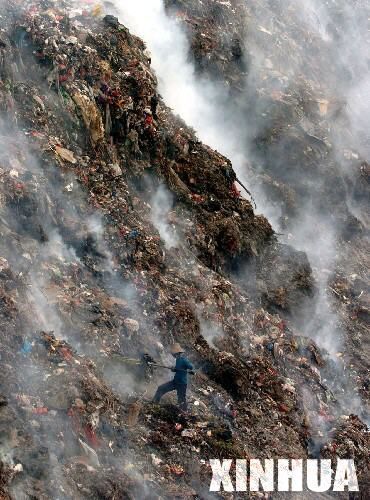By 2012 half of Beijing's garbage will be disposed of through incineration and biochemical treatment, both of which are more environment-friendly than the present landfill approach. According to the Beijing Municipal Commission of City Administration, the city will strive to build more new waste-treatment facilities and reduce landfill disposal over the next few years.
 |
|
File photo: Garbage piled up like a mountain. |
A commission official warned on June 8 that at the current annual growth rate of garbage discharge of 8 percent, Beijing would run out of space in its 13 landfills over the next four years. To resolve the problem, he explained on June 9 that Beijing will improve urban waste-treatment technology and capacity and give priority to planning and constructing waste-treatment facilities. Priority will be given to the technologies of incineration, integrated disposal, and utilization of dining and kitchen waste as resources. More investment will go to household waste treatment.
According to the commission's plan, by 2012 Beijing's waste-processing capacity will reach 17,000 tons per day, and the ratio of incineration to biochemical disposal to landfill will be 20:30:50, with a 40 percent decrease in landfill disposal. By 2015 the waste-processing capacity will reach 30,000 tons per day, and the ratio between the three disposal approaches will be 40:30:30.
The city has also planned to reduce the growth rate in garbage discharge by one or two percent per year.
About 40 waste-treatment facilities are expected to be built by 2015 to help dispose of kitchen waste, including five centralized treatment facilities providing cross-district service and seven serving the outer districts and counties.
Meanwhile, the commission advocates waste-sorting throughout the city to reduce garbage discharge at source. Beijing will strive to have 10 percent of the total population and 30 percent of government bodies and schools educated in waste-sorting standards this year. Moreover, the city will complete the treatment of landfill gas generated from present facilities by the end of the year, and the adaption of leachate treatment facilities by 2010.
(China.org.cn by Li Xiao, June 11, 2009)